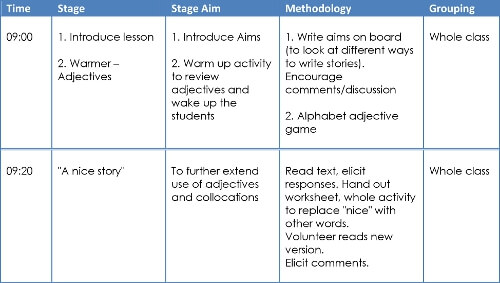How to Write a
Daily Lesson Plan Template
 When
you take
a job teaching ESL, your employer may have a daily lesson
plan template you will be required to use.
When
you take
a job teaching ESL, your employer may have a daily lesson
plan template you will be required to use. Click Here for Step-by-Step Rules, Stories and Exercises to Practice All English Tenses
If they do, they will also explain how to complete it.
However, not every school provides a template for you.
And even if they don't require you to complete a lesson plan for every lesson, it is good practice, because you will make sure that your lessons are:
- Logically planned
- Have a good mix of activities
- Give enough speaking time to the students
- Have a clear aim
This is, in fact, the main reason why experienced teachers seem to spend less time planning; they have taught the lessons before and they know exactly what works and what doesn't work.
Designing a Lesson Plan Template
If you need to design a template for your lesson plans, it is a good idea to save it on a computer so you can either type your lesson plans onto it, or print it and hand write the plans if you need to.There are a number of things that should be included on your lesson plan template:
- Time
- Lesson stage
- Stage aim
- Methodology
- Interaction/grouping
- Materials
you will use during the lesson
- Notes on individual
students and any differentiation needed
- Space to evaluate
the lesson
- Space to outline any potential problems you foresee during the lesson, and how you plan to overcome them
What should a lesson plan template look like?
Here is a scaled down version of one example, with some content added as an example (click to enlarge):
Of course, there are many variations on this template, and some teachers like to add more detail than others.
If you are happier writing down every stage of your lesson, along with a script of what you will say, and a plan of what you will write on the board, then that's fine.
If you are happy with major stages outlined, with little detail, then that's also OK.
You will also probably want a cover sheet which outlines the general aim of the lesson, details the teacher's name, the class name and the date. This could also include some of the other details suggested above.
If you are organized with your paperwork, and you get into a routine, it isn't difficult to write lesson plans for every lesson. And if you keep them filed with materials you've used, then you will always have lessons available at short notice if you need to cover a different class unexpectedly.
They are also great to show prospective employers at an interview.
Whichever kind of daily lesson plan template you use, you can be sure that it will help you organize your teaching and be a better teacher.
Get Updates, Special Offers, and English Resources
Download your FREE GIFT (the first two chapters of
English Short Stories Book and Workbook)
as soon as you join!

By submitting your email, you consent to receiving updates and newsletters from us and to the sharing of your personal data with third parties for the purposes of sending you communications. We will not spam you. You can unsubscribe at any time. For more information, please see our privacy policy.





